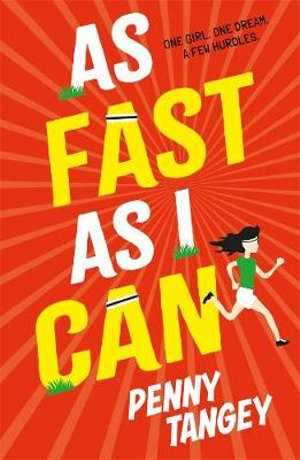Penny Tangey writes humorous books for young people. Her book, Stay Well Soon, was shortlisted for the New South Wales and Western Australian Premier’s awards and the Readings Children’s Book Prize. Penny studied Arts/Science at Melbourne University majoring in Chemistry and Indonesian. While at university Penny performed stand-up comedy, including in the Melbourne International Comedy Festival. Penny now works as a researcher for television quiz shows Hard Quiz and The Chase, but is still terrible at trivia.
Today, she’s on the blog to tell us about her latest book, As Fast As I Can, and how she writes issues-based children’s books. Read on!
When I was a child, I liked books about serious topics that were often far removed from my own life. I think these books helped me develop compassion for other people with experiences different from my own. As an adult I’m drawn to writing books for kids that engage with some of the sadnesses and challenges in life.
My middle reader, As Fast As I Can, is about a girl with a hereditary heart condition called long QT syndrome. The condition is serious but treatable with medication and major lifestyle changes. People with long QT syndrome can be asymptomatic and the first sign of the illness can be cardiac arrest or sudden death.
Writing about long QT meant discussing mortality, medical treatments, disability and personal risk. I wanted to do justice to the complexity and seriousness of these issues both for readers who are directly dealing with heart disease, and for those who are learning about it for the first time.
There are lots of ways that writers ensure their stories are sensitive and accurate, and I’ve outlined my process below.
1. Asking if I’m the right person to tell the story
I first learned about long QT syndrome when my cousin and her son were diagnosed five years ago. Long QT is strongly hereditary, so it was possible I also had the condition and may have passed it on to my children. This was eventually ruled out by genetic testing. This family experience gave me the central idea for As Fast As I Can: An apparently healthy girl, who dreams of being an elite athlete but has to grapple with some major hurdles.
After having the idea, I considered whether I should tell this story and whether I could tell it well. I don’t have a heart condition, but I have a personal connection through my family. I decided I would do my best to write the story in a meaningful way, but I would only publish the book if my family members were happy with the portrayal.
2. Research
I already knew a little about long QT syndrome through talking to family members, and from personal research when I thought I might have the condition. To write a book about it, I needed more detail. For the medical aspects of the story, my first step was to speak to a doctor who gave me an overview of long QT and its symptoms and treatments.
I also looked for first-hand accounts of people diagnosed with a hereditary heart condition to give me more insight into what living with long QT syndrome is really like. Rather than approaching people directly, I looked for resources that already existed. There are many personal stories on blog posts, heart foundation websites and forum discussions.
3. Feedback
Outside of close friends and family, if I ask people with specific personal experience to provide feedback on my writing, I offer, and expect, to pay. This is fair and shows them that I value their time and experience.
I asked my cousin to read the manuscript, as she has long QT syndrome. I was very nervous because her opinion was very important to me. If she hadn’t liked As Fast As I Can, I wouldn’t have published it. I was pleased when she gave me very generous feedback and said she supported the book. I made changes based on her comments, including to the final scene.
A medical professional also read the book and gave very helpful advice that allowed me to add more detail to the medical scenes.
4. Fact checking
Before the book was published, I wrote a document outlining every mention of long QT in the story. I provided references for each of these. This process led me to correct some errors and inconsistencies. This fact checking task made me feel more confident that I’d been thorough and could justify the information about long QT in the story.
–Penny Tangey
As Fast As I Can by Penny Tangey (University of Queensland Press) is out now. Find out more about Penny here.

As Fast As I Can
One girl. One dream. A few hurdles.
Ten-year-old Vivian is determined to win a medal at the Olympic Games one day. Problem is, she hasn't found a sport she's any good at yet. But everyone says if you work hard enough you can achieve anything, right? So when Vivian discovers she has a talent for cross country running, finally, her Olympic dream might actually come true. But then a family illness is uncovered and all of Vivian's plans begin to unravel. Can she keep her dream alive?...







Comments
No comments